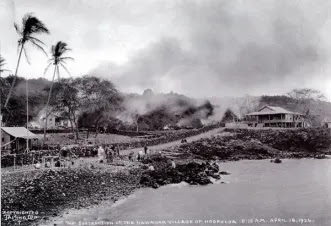One Mauna loa eruption began on May 19th, 1916, and was brief, lasting less than two weeks, but it offers lessons for future Mauna Loa eruptions.
Dr. Thomas Jaggar, who had founded the Hawaiian Volcano Observatory a mere four years earlier in 1912, attempted to forecast the next Mauna Loa eruption based on the pattern of rift zone eruptions on the volcano since 1868. The previous rift eruptions alternated locations between the Northeast Rift Zone and the Southwest Rift Zone though these were frequently separated in time by eruptions confined to Mauna Loa's summit caldera, Moku‘āweoweo.
During the year of the founding of Hawai'i Volcanoes National Park, the May 19, 1916 Southwest Rift Zone outbreak deviated from the pattern of eruptions Dr. Jaggar had observed at Mauna Loa, suggesting that the eruption probability might be more like a “coin flip” model. While the long-term odds for flipping heads and tails are equal, it doesn’t mean you can’t flip four tails in a row.
Like many eruptions on the Island of Hawai‘i, the May 19th, 1916, eruption was preceded by earthquake activity. Residents of Ka‘ū felt numerous earthquakes early in the morning before an impressive steam plume, visible from Kīlauea’s summit, rose high up on Mauna Loa’s SWRZ at about 7:15 a.m., marking the start of the eruption. Activity in this high-elevation area, technically considered the summit region, lasted less than 24 hours.
Later, another swarm of earthquakes shook Ka‘ū residents as lava intruded the Southwest Rift Zone resulting in a line of fissures opening on the evening of May 21. Lava from the vents spread over the crest of the rift zone feeding lava flows on either side—the Honomalino flow moving down the steep southwest side and the larger Kahuku flow spreading more widely to the southeast.
The branched nature of the 1916 eruption—with the eruption supplying lava flows on either side of the rift zone—coupled with the relatively small total erupted volume ensured that the lava flows did not travel very far. Only one homestead, the Bertlemann’s, was destroyed during the 1916 eruption, which ended on May 31.
The 1916 eruption was followed in relatively rapid succession by Mauna Loa’s 1919 and 1926 Southwest Rift Zone eruptions with no intervening eruptions. During both eruptions, lava flows reached the ocean and destroyed Hawaiian coastal villages Alika and Hoʻōpūloa. The 1919 and 1926 lava flows would have cut Highway 11 and caused severe disruptions for current residents. The village of Miloliʻi and its boat access were narrowly missed by the 1926 flow.
 |
| The lava flow that destroyed Hoʻōpūloa in 1926. Photo courtesy of Peter T. Young |
The 1950 eruption on the Southwest Rift Zone was the largest recorded Mauna Loa eruption and fed flows on either side of the rift zone crest like the 1916 eruption. In a contrast to the 1916 eruption, three lava flows erupted in 1950 entered the ocean within less than 24 hours of that eruption starting. A repeat of the 1950 eruption is of great concern today due to the increased population of the area.
 |
| The 1950 eruption of Mauna Loa was its fastest high volume eruption in recorded history. |
m. Over the past 200 years, Mauna Loa rift zone eruptions are evenly divided between the Southwest Rift Zone and the Northeast Rift Zone. However, the remarkable run of four Southwest Rift Zone eruptions in a row (1907, 1916, 1919, 1926) shows the weakness of long-term normal probability models in forecasting eruptions in the short term. It’s a constant reminder that none of us should grow complacent living on our volcanic island.
Volcano Activity Updates: Kīlauea volcano is erupting. Its USGS Volcano Alert level is at WATCH (https://www.usgs.gov/natural-hazards/volcano-hazards/about-alert-levels). Kīlauea updates are issued daily.
Over the past week, lava has continued to erupt from the western vent within Halemaʻumaʻu crater. All lava is confined within Halemaʻumaʻu crater in Hawai‘i Volcanoes National Park. Sulfur dioxide emission rates remain elevated and were last measured at approximately 2,800 tonnes per day (t/d) on May 12.
Seismicity is elevated but stable, with few earthquakes and ongoing volcanic tremor. Summit tiltmeters show relatively little ground
deformation over the past week. For more information on the current eruption of Kīlauea, see https://www.usgs.gov/volcanoes/kilauea/recent-eruption.
Mauna Loa is not erupting and remains at Volcano Alert Level ADVISORY. This alert level does not mean that an eruption is imminent or that progression to an eruption from the current level of unrest is certain. Mauna Loa updates are issued weekly.
 |
| The 1950 eruption of Mauna Loa reached the ocean in three hours. It burned about a mile of highway. Photo from U.S. Military Transport Service |
Four earthquakes were reported felt in the Hawaiian Islands during the past week: a M3.2 earthquake 21 km (13 mi) SSE of Nāʻālehu at 13 km (8 mi) depth on May 19 at 2:03 a.m. HST, a M3.1 earthquake 3 km (1 mi) SSE of Pāhala at 32 km (20 mi) depth on May 18 at 12:14 a.m. HST, a M2.6 earthquake 21 km (13 mi) SSE of Waimea at 22 km (13 mi) depth on May 15 at 10:48 p.m. HST, and a M3.2 earthquake 2 km (1 mi) WSW of Pāhala at 35 km (22 mi) depth on May 13 at 5:46 a.m. HST.
HVO continues to closely monitor Kīlauea’s ongoing eruption and Mauna Loa for any signs of increased activity.
Visit HVO’s website for past Volcano Watch articles, Kīlauea and Mauna Loa updates, volcano photos, maps, recent earthquake info, and more. Email questions to askHVO@usgs.gov.
 |
| Image of the steam plume that accompanied the start of Mauna Loa’s 1916 eruption on the Southwest Rift Zone. View is from within Hawai‘i Volcanoes National Park, with Kīlauea caldera wall visible in the middle of the photo. Photo by H. Wood, courtesy of University of Hawai‘i at Mānoa Hamilton Library. |
A MAGNITUDE 4.7 EARTHQUAKE WITHIN HUALALAI VOLCANO shook the entire island at 11:50 p.m. Saturday. USGS reported moderate shaking, with a maximum instrumental intensity of V on the Modified Mercalli Intensity Scale ."At that intensity, very light damage to buildings or structures could occur." The USGS Did You Feel It? service received more than 1020 felt reports within the first hour of the earthquake.
USGS reported that during the past 25 years, there were two earthquakes with magnitudes greater than 4.0 beneath Hualalai volcano, including Saturday night's event. USGS described it as a " primarily lateral slip along a sub-vertical fault and does not appear to be directly related to magmatic activity. Aftershocks are likely, and some may be felt."
HVO Scientist-in-Charge Ken Hon said the earthquake had no apparent effect on Mauna Loa or Kīlauea Volcano’s ongoing summit eruption. "HVO monitoring networks have not detected any significant changes in activity at the summit or along the rift zones of Kīlauea resulting from the earthquake.
IRONWORKERS LOCAL 625 GAVE ITS ENDORSEMENT FOR KAʻŪ into Kona state House of Representative to Jeanné Kapela. The Democrat made the announcement on Sunday. Kapela stated, "It is springtime for
our economy. After two years of fiscal hardship, our state's financial outlook is gleaming. Instead of cutting services, we are investing in programs to uplift the working families who drive our islands forward.
"That's why I am proud to be endorsed by Ironworkers Local 625 in my race for reelection to the State House. Each day, their members are forging a stronger future for our islands, from much needed affordable housing to 21st Century schools to state-of-the-art transportation systems.
"When labor succeeds, everyone prospers. To champion the workers on whom our economy depends, donate today to our campaign for change. Every dollar you contribute will be spent delivering financial security for our community.
"Labor rights are human rights. I will always stand with the workers who are constructing an enduring foundation for our society's well-being," said Kapela.
 |
| Jeanné Kapela announces support from the Ironworkers Union |
"That's why I am proud to be endorsed by Ironworkers Local 625 in my race for reelection to the State House. Each day, their members are forging a stronger future for our islands, from much needed affordable housing to 21st Century schools to state-of-the-art transportation systems.
"When labor succeeds, everyone prospers. To champion the workers on whom our economy depends, donate today to our campaign for change. Every dollar you contribute will be spent delivering financial security for our community.
"Labor rights are human rights. I will always stand with the workers who are constructing an enduring foundation for our society's well-being," said Kapela.
To read comments, add your own, and like this story, see www.facebook.com/kaucalendar/. See latest print edition at www.kaucalendar.com. See upcoming events at https://kaunewsbriefs.blogspot.com/2022/04/upcoming-events-for-kau-and-volcano.html
AUDITIONS FOR THE MIKADO are being held on 6:30 p.m. on Monday, May 23 and Tuesday, May 24 at Kīlauea Theater within Kīlauea Military Camp in Volcano. The show is being put on by Kīlauea Drama& Entertainment Network. All ages and ability are welcome to audition. Auditioneers should be prepared to sing a song that best shows their vocal range and dress comfortably to move on the stage. There will be cold readings as well. For more information call 982-7344 or email kden73@aol.com.
MEMORIAL DAY LEI for keiki ages 5 to 12 years old on Tuesday, May 24 from 2:30 - 4 p.m. at Kahuku Park in Ocean View. Registration is open from May 13 - 20. To register, contact Recreation Technician III, Teresa Anderson, at (808) 938-4875.
MEMORIAL DAY CRAFT for keiki in grades K-6th on Tuesday, May 24 from 3 - 4:30 p.m. at Kaʻū District Gym & Pāhala Community Center. Registration is open from May 16 - 20. To register, contact Recreation Director II, Nona Makuakane, at (808) 928-3102.
‘O KA’Ū KĀKOU MARKET, in Nāʻālehu, open Wednesdays and Saturdays, 8 a.m. to 2 p.m. Contact Nadine Ebert at 808-938-5124 or June Domondon 808-938-4875. See facebook.com/OKauKakouMarket.
MEMORIAL DAY CRAFT for keiki in grades K-6th on Tuesday, May 24 from 3 - 4:30 p.m. at Kaʻū District Gym & Pāhala Community Center. Registration is open from May 16 - 20. To register, contact Recreation Director II, Nona Makuakane, at (808) 928-3102.
‘O KA’Ū KĀKOU MARKET, in Nāʻālehu, open Wednesdays and Saturdays, 8 a.m. to 2 p.m. Contact Nadine Ebert at 808-938-5124 or June Domondon 808-938-4875. See facebook.com/OKauKakouMarket.
SEE UPCOMING EVENTS IN KAʻŪ & VOLCANO
LEARN MORE ABOUT SPONSORS OF THE KAʻŪ CALENDAR





